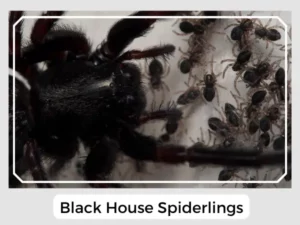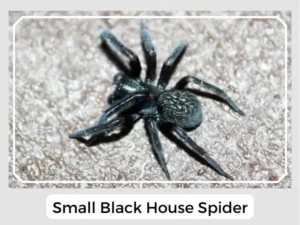The Black House Spider, sometimes called the common black spider, calls Australia home. But, you can also spot them in Japan and New Zealand. They have a dark, strong look but are quite shy. They pop out for a quick meal and then dash back home. We’ve got cool facts about them, so keep reading!
The eggs, predominantly spherical, find their sanctuary within numerous sacs spun from pristine white silk. The vigilant mother remains steadfast in her progeny, ensuring their safety until they reach maturation.
The spiderlings linger within the safety of their maternal web, biding their time before they eventually embark on their solitary journey.

Photo Credit: Tom Musson
Characterized by its chaotic beauty, the Black House Spider’s web is a display of disarray, centering around a funnel-shaped retreat. This becomes the spider’s primary hideout, a strategic point for ambushing prey. Traces of daily life, such as minute debris or dust, may speckle the web, a testament to the spider’s reluctance to abandon its silken fortress unless absolutely necessary.
Yes, Black House spiders do have venom. They use it mainly to catch their meals, but usually, it’s not very harmful to humans.
These timid spiders hardly bite, but if they do it could be painful, causing the area to swell which then needs first aid. Other symptoms like giddiness, nausea, vomiting, and sweating have also been recorded. Multiple bites have also resulted in skin lesions, though in rare cases.
Though venomous, these spiders are not deadly, and their bite would not cause death.

Photo Credit: Arthur D. Chapman
Black House Spiders play a crucial role in maintaining the ecological balance in their habitats. They help control the population of various insects such as bees, butterflies, ants, and flies, ensuring that these species do not overrun their environments. Their web-building activities also contribute to the dispersion of silk particles in the environment, which can be important for various ecological processes.
The behavior of Black House Spiders is quite intriguing. They are known to be shy, preferring to stay hidden in their messy, funnel-shaped webs and only emerging when there is an opportunity for a quick meal.
Natural Predator: The Black House Spider is not without its enemies in the wild. It falls prey to several natural predators, including the White-tailed Spider, parasitic wasps, and flies. These predators have developed specialized strategies to overcome the spider’s defenses, showcasing the intricate predator-prey dynamics in their ecosystem.
Prey-Predator Dynamics: The relationship between the Black House Spider and its predators is a complex dance of evasion and pursuit. The spider relies on its web and its elusive behavior to evade predators, while the predators have evolved ways to navigate the spider’s defenses and capture it. This ongoing battle for survival is a testament to the dynamic and ever-evolving nature of ecological relationships.
Relationship with Humans: While Black House Spiders do possess venom, their interactions with humans are relatively benign. Bites are rare and usually occur only when the spider is provoked or feels threatened. It is important for humans to understand the spider’s behavior and to approach it with caution, respecting its space and its role in the ecosystem.
| Lifespan | About 2 years after maturation, females live longer |
| Distribution | Southern and eastern parts of Australia as well as Japan and New Zealand |
| Habitat | On rough-barked trees, inside buildings, near doorways, and windows |
| Common Predators | White-tailed spider, parasitic wasps, flies |
| Diet | Bees, butterflies, ants, beetles, flies |
In conclusion, the Black House Spider is a captivating creature that plays a vital role in its ecosystem.
The Black House Spider, sometimes called the common black spider, calls Australia home. But, you can also spot them in Japan and New Zealand. They have a dark, strong look but are quite shy. They pop out for a quick meal and then dash back home. We’ve got cool facts about them, so keep reading!
The eggs, predominantly spherical, find their sanctuary within numerous sacs spun from pristine white silk. The vigilant mother remains steadfast in her progeny, ensuring their safety until they reach maturation.
The spiderlings linger within the safety of their maternal web, biding their time before they eventually embark on their solitary journey.

Photo Credit: Tom Musson
Characterized by its chaotic beauty, the Black House Spider’s web is a display of disarray, centering around a funnel-shaped retreat. This becomes the spider’s primary hideout, a strategic point for ambushing prey. Traces of daily life, such as minute debris or dust, may speckle the web, a testament to the spider’s reluctance to abandon its silken fortress unless absolutely necessary.
Yes, Black House spiders do have venom. They use it mainly to catch their meals, but usually, it’s not very harmful to humans.
These timid spiders hardly bite, but if they do it could be painful, causing the area to swell which then needs first aid. Other symptoms like giddiness, nausea, vomiting, and sweating have also been recorded. Multiple bites have also resulted in skin lesions, though in rare cases.
Though venomous, these spiders are not deadly, and their bite would not cause death.

Photo Credit: Arthur D. Chapman
Black House Spiders play a crucial role in maintaining the ecological balance in their habitats. They help control the population of various insects such as bees, butterflies, ants, and flies, ensuring that these species do not overrun their environments. Their web-building activities also contribute to the dispersion of silk particles in the environment, which can be important for various ecological processes.
The behavior of Black House Spiders is quite intriguing. They are known to be shy, preferring to stay hidden in their messy, funnel-shaped webs and only emerging when there is an opportunity for a quick meal.
Natural Predator: The Black House Spider is not without its enemies in the wild. It falls prey to several natural predators, including the White-tailed Spider, parasitic wasps, and flies. These predators have developed specialized strategies to overcome the spider’s defenses, showcasing the intricate predator-prey dynamics in their ecosystem.
Prey-Predator Dynamics: The relationship between the Black House Spider and its predators is a complex dance of evasion and pursuit. The spider relies on its web and its elusive behavior to evade predators, while the predators have evolved ways to navigate the spider’s defenses and capture it. This ongoing battle for survival is a testament to the dynamic and ever-evolving nature of ecological relationships.
Relationship with Humans: While Black House Spiders do possess venom, their interactions with humans are relatively benign. Bites are rare and usually occur only when the spider is provoked or feels threatened. It is important for humans to understand the spider’s behavior and to approach it with caution, respecting its space and its role in the ecosystem.
| Lifespan | About 2 years after maturation, females live longer |
| Distribution | Southern and eastern parts of Australia as well as Japan and New Zealand |
| Habitat | On rough-barked trees, inside buildings, near doorways, and windows |
| Common Predators | White-tailed spider, parasitic wasps, flies |
| Diet | Bees, butterflies, ants, beetles, flies |
In conclusion, the Black House Spider is a captivating creature that plays a vital role in its ecosystem.